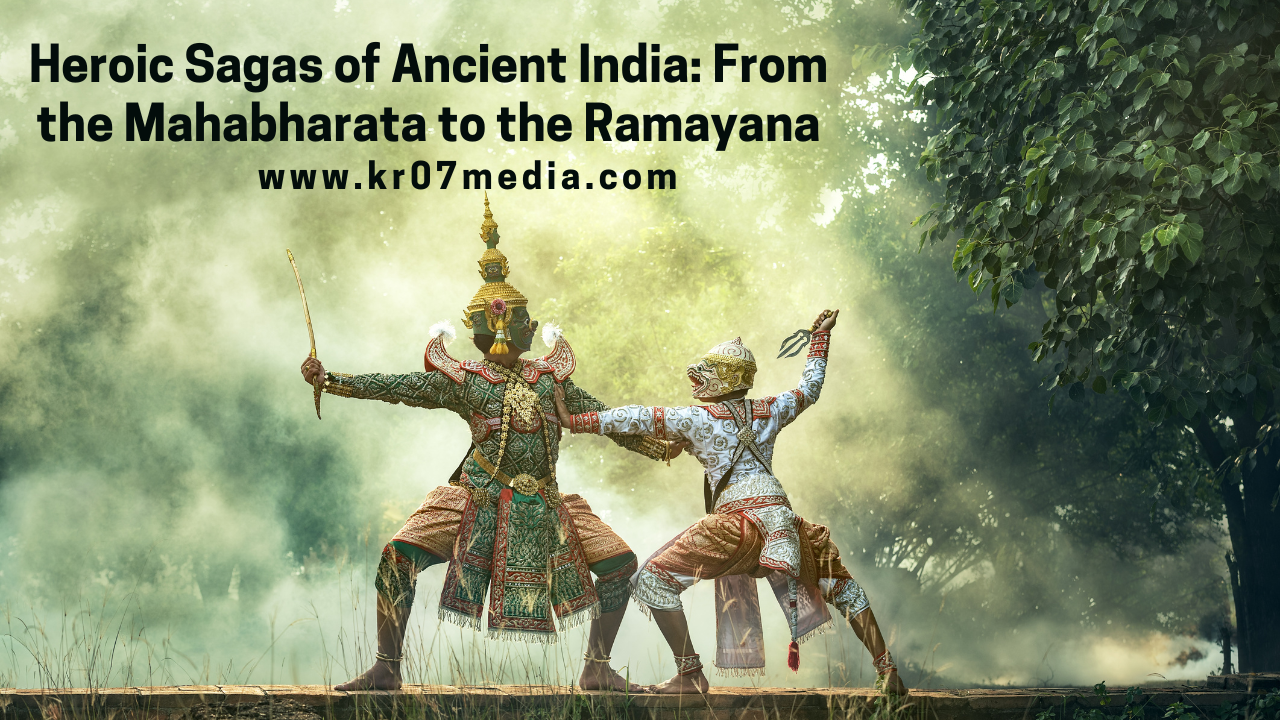India's rich cultural heritage is intertwined with the profound stories of the Mahabharata and the Ramayana. These two epics are not only revered as great literary and religious texts but also as sources of timeless wisdom, morality, and inspiration. Through tales of heroism, virtue, and valor, they depict a broad spectrum of human emotions and philosophical insights, offering lessons that have endured for thousands of years. The characters and events within these epic tales have transcended time, influencing Indian culture, art, literature, and spirituality.
The Mahabharata: The Epic of Conflict and Dharma
The Mahabharata, attributed to the sage Vyasa, is one of the longest epic poems in the world, encompassing over 100,000 verses. It narrates the legendary Kurukshetra War, a dynastic battle between the Pandavas and the Kauravas, two branches of the Kuru dynasty. Yet, the Mahabharata is not merely a tale of war; it delves deep into the complexities of human life, exploring concepts of dharma (righteousness), justice, and duty.
At the heart of this grand epic is the Bhagavad Gita, a spiritual dialogue between Prince Arjuna and Lord Krishna, who serves as his charioteer and guide. This conversation unfolds on the battlefield, where Arjuna grapples with the moral dilemma of fighting against his own kin. The Gita addresses existential questions about the soul, duty, and the nature of life, making it one of the most philosophical discourses in Hinduism. The teachings of the Gita emphasize the importance of duty, detachment, and devotion, urging individuals to act in harmony with cosmic law.
The Mahabharata introduces a pantheon of heroic figures, each exemplifying different virtues and flaws. Bhishma, the grand patriarch, epitomizes sacrifice and loyalty, while Karna is celebrated for his generosity and valor. Draupadi, the queen of the Pandavas, symbolizes resilience and strength in adversity. Through these characters, the Mahabharata illustrates the moral ambiguities of life, revealing that the path of righteousness is often filled with struggle.
The Ramayana: The Ideal of Virtue and Devotion
The Ramayana, composed by the sage Valmiki, recounts the journey of Lord Rama, an avatar of Vishnu, and his quest to rescue his wife, Sita, from the demon king Ravana. This epic encapsulates ideals of virtue, loyalty, and devotion, presenting Lord Rama as the maryada purushottama (the perfect man) who upholds dharma in the face of adversity. His unwavering commitment to righteousness, even at great personal cost, serves as an exemplar for individuals seeking to lead a life of integrity and honor.
Central to the Ramayana is the relationship between Rama and Sita, whose devotion to each other is a testament to the sanctity of marital bonds. Sita's purity and strength, particularly during her captivity in Lanka, embody resilience and faith. Hanuman, the devoted monkey-god and loyal servant of Rama, exemplifies courage, selflessness, and undying devotion, making him a beloved figure in Hindu culture.
The story unfolds in various locations, from the kingdom of Ayodhya to the forests of exile, and across the ocean to Lanka, illustrating a vast geographical landscape. Each setting contributes to the narrative, imbuing it with a sense of mythic grandeur. The Ramayana also addresses themes of governance and the role of a ruler, highlighting the responsibilities of leadership. Rama’s adherence to his duty as a king, even when it demands personal sacrifice, underscores the importance of selflessness in governance.
Common Themes: Dharma and the Human Experience
Both the Mahabharata and the Ramayana grapple with the concept of dharma—the cosmic order that governs the universe and dictates moral and ethical conduct. However, each epic offers a different perspective. In the Mahabharata, dharma is portrayed as complex and multifaceted, often presenting the characters with morally ambiguous choices. The Ramayana, on the other hand, presents a more absolute view of dharma, with Rama embodying the ideal of righteousness.
Another common theme is the exploration of heroism and sacrifice. Heroes in these epics, whether Arjuna in the Mahabharata or Rama in the Ramayana, are not only warriors but also individuals who are bound by duty. Their journeys underscore the belief that heroism is not merely a matter of physical strength but also of moral integrity and inner resilience.
Influence on Indian Culture and Beyond
The impact of the Mahabharata and the Ramayana on Indian culture is immeasurable. These epics have been retold in various forms, from folk tales to dance, theater, and modern adaptations. Festivals like Dussehra and Diwali, celebrating the victory of good over evil, draw inspiration from these ancient stories. The teachings and values embedded in these epics continue to resonate with people, influencing ethical and social norms across generations.
Globally, these epics have attracted interest for their universal themes of good versus evil, the complexities of human relationships, and the quest for purpose and meaning. Translations and adaptations in various languages have made these texts accessible to diverse audiences, fostering an appreciation of ancient Indian wisdom and spirituality.
Conclusion
The Mahabharata and the Ramayana are not just stories of ancient India but are profound reflections on the human condition. They delve into the struggles between duty and desire, right and wrong, strength and vulnerability, and ultimately, the quest for self-realization. Through tales of valor, sacrifice, and enduring faith, these epics offer timeless wisdom and a moral compass for navigating life’s challenges. In a world that constantly grapples with questions of justice, morality, and purpose, the heroic sagas of ancient India continue to illuminate the path forward.



